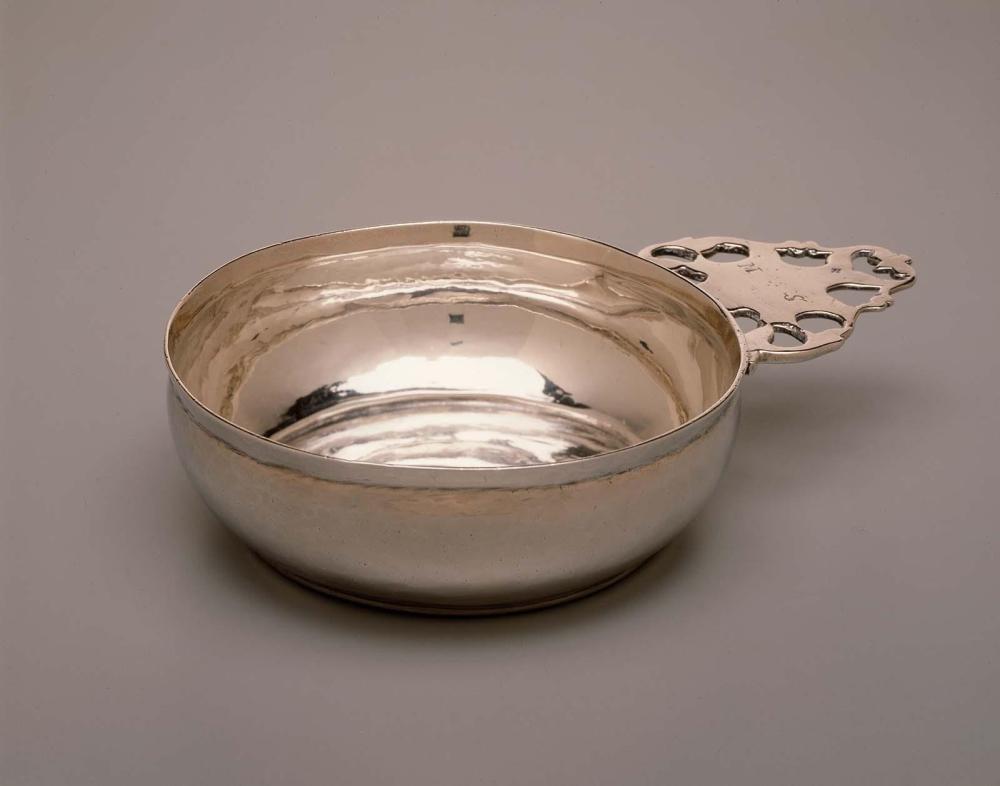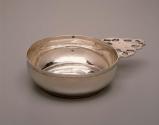Advanced Search
Porringer
Jeremiah Dummer (American, 1645–1718)
1690–1700
Object Place: Boston, Massachusetts
Medium/Technique
Silver
Dimensions
3.3 x 15.6 cm (1 5/16 x 6 1/8 in.)
Credit Line
Museum purchase with funds donated by a friend of the Department of American Decorative Arts and Sculpture
Accession Number1985.410
NOT ON VIEW
CollectionsAmericas
ClassificationsSilver hollowware
Porringers were widely used in the colonial period, judging from the numbers that have survived. After spoons, they were probably the most commonly listed piece of silver in colonial inventories, attesting to their usefulness in the household. Hot liquids no doubt made the decorative piercings both handsome and functional, for they cooled the handle for users such as Judge Samuel Sewall (1652 – 1730), who wrote on September 11, 1704, that he was “threaten’d with my sore throat: but I went to Bed early . . . pin’d m y Stocking about my Neck, [and] drunk a porringer of Sage Tea upon which I sweat very kindly.”
Jeremiah Dummer produced a variety of porringer handles, ranging from simple trefoils to complicated geometric compositions. This early porringer is one of a small group notable for their geometric handles bearing nine pierced forms, a style seen in few others by Dummer from this early period. One remarkable example bears the mark of René Grignon (about 1652 – 1714/15) along with an erased Dummer mark (now in the Yale collection). It prompts the theory advanced by Kathryn C. Buhler and Graham Hood that Grignon, a French Huguenot who worked briefly in Boston and later settled in Norwich, Connecticut, may have “repaired or resold an original Dummer porringer.”2 Since the Grignon porringer handle has a smooth and fully articulated surface, the cast may have been enhanced by him or taken from a Dummer example other than this one, which is flat and somewhat worn.
Dummer’s mark on the Grignon porringer demonstrates the practicality of colonial silversmiths, who readily used the decorative silver elements that passed through their workshops. The presence of an incuse fleur-de-lis on the handle is unexplained.
This text has been adapted from "Silver of the Americas, 1600-2000," edited by Jeannine Falino and Gerald W.R. Ward, published in 2008 by the MFA. Complete references can be found in that publication.
Jeremiah Dummer produced a variety of porringer handles, ranging from simple trefoils to complicated geometric compositions. This early porringer is one of a small group notable for their geometric handles bearing nine pierced forms, a style seen in few others by Dummer from this early period. One remarkable example bears the mark of René Grignon (about 1652 – 1714/15) along with an erased Dummer mark (now in the Yale collection). It prompts the theory advanced by Kathryn C. Buhler and Graham Hood that Grignon, a French Huguenot who worked briefly in Boston and later settled in Norwich, Connecticut, may have “repaired or resold an original Dummer porringer.”2 Since the Grignon porringer handle has a smooth and fully articulated surface, the cast may have been enhanced by him or taken from a Dummer example other than this one, which is flat and somewhat worn.
Dummer’s mark on the Grignon porringer demonstrates the practicality of colonial silversmiths, who readily used the decorative silver elements that passed through their workshops. The presence of an incuse fleur-de-lis on the handle is unexplained.
This text has been adapted from "Silver of the Americas, 1600-2000," edited by Jeannine Falino and Gerald W.R. Ward, published in 2008 by the MFA. Complete references can be found in that publication.
DescriptionThe small raised porringer, with a center point visible inside its domed bowl, has convex sides and an everted rim. The cast pear-shaped handle has nine pierced geometric shapes, at least two of which resemble tulips. It is soldered at right angles to the rim. A repair to a vertical break on the wall is visible to the right of the handle.
Marks
Under handle is stamped "I [pellet] D" within a heart-shaped device, over a fleur-de-lis. On top of handle, above inscription is a small, incuse fleur-de-lis.
Inscriptions"M * S" engraved on handle in shaded roman letters, facing bowl.
ProvenanceEarly history unknown. Probably owned by Francis Hill Bigelow and sold at American Art Association/Anderson Galleries, Inc., in 1936; owned in 1939 by William T. H. Howe (Yale College, Class of 1893); later purchased by Mark Bortman; to Bortman-Larus Americana Foundation; sold by Bortman-Larus through William Duffy to the MFA. (Accession Date: September 24, 1985)



